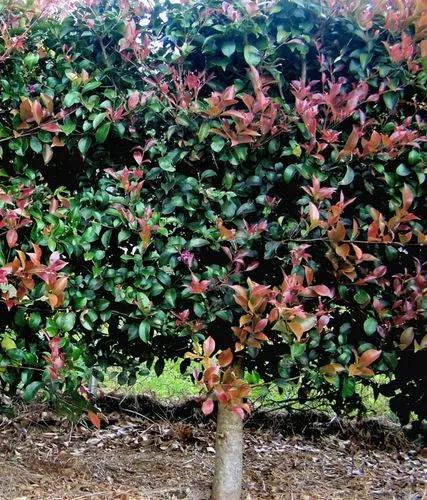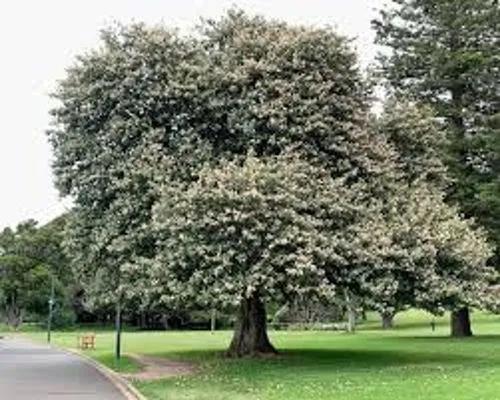This very symmetrical plant supports a crown of shiny, dark green leaves on a thick shaggy trunk that is typically about 20 cm (7.9 in) in diameter, sometimes wider. The trunk is very low to subterranean in young plants, but lengthens above ground with age. It can grow into very old specimens with 6–7 m (over 20 feet) of trunk; however, the plant is very slow-growing and requires about 50–100 years to achieve this height. Trunks can branch several times, thus producing multiple heads of leaves. The leaves are a deep semiglossy green and about 50–150 cm (20–59 in) long when the plants are of a reproductive age. They grow out into a feather-like rosette to 1 m (3.3 ft) in diameter. The crowded, stiff, narrow leaflets are 8–18 cm (3.1–7.1 in) long and have strongly recurved or revolute edges. The basal leaflets become more like spines. The petiole or stems of the sago cycad are 6–10 cm (2.4–3.9 in) long and have small protective barbs. Roots are called coralloid with an Anabaena symbiosis allowing nitrogen fixation.[5] Tannins-rich cells are found on either side of the algal layer to resist the algal invasion. As with other cycads, it is dioecious, with the males bearing pollen cones (strobilus) and the females bearing groups of megasporophylls. Pollination can be done naturally by insects or artificially.
Cyca Revolut Care
Cycas Revoluta



How to Care for the Plant

Water

Water regularly while letting the soil mix dry in the surface before watering again. watering must be regular but limited, in order to not suffocate the plant's roots.

Pruning

To prune a plant to encourage bushy new growth, snip off the dominant buds on select stems, staggering the cuts to encourage varied growth.

Fertilizer

Simply apply the fertilizer around the base of the plant, extending to the drip line. For vegetables, place the fertilizer in a strip parallel to the planting row. Water-soluble fertilizers are faster acting but must be applied more frequently. This method gives plants food while you water.

Sunlight

In most cases, plants receiving no outdoor light should be lit from 16 to 18 hours each day. If some additional light is received, 12 to 14 hours each day may be adequate. Lights should be used at the same time that plants receive window light.

Soil

The ideal blend of soil for plant growth is called loam. Often referred to as topsoil or black dirt by landscape companies, loam is a mixture of sand, clay, and silt.

Temperature

Temperature: Temperature: Average room temperatures of 65°F (16°C) --- 75°F (24°C) are suitable and no lower than 55°F (12.7°C). Light: The cycas revoluta grows at it's best with bright light, without direct sunlight.

Container

Ceramic pots are the most popular type of containers for houseplants today. You'll find them in all kinds of styles, colors, and sizes. At one time, the clay pot was the most common container for indoor plants. When choosing a pot, choose a pot that is 2.5-5 cm (1-2”) larger than the current size.

Additional

Toxicity. Cycad sago is extremely poisonous to animals (including humans) if ingested. ... Effects of ingestion can include permanent internal damage and death. All parts of the plant are toxic; however, the seeds contain the highest level of the toxin cycasin.

Popularity

40,528 people already have this plant 2,926 people have added this plant to their wishlists
Discover more plants with the list below
Popular articles






